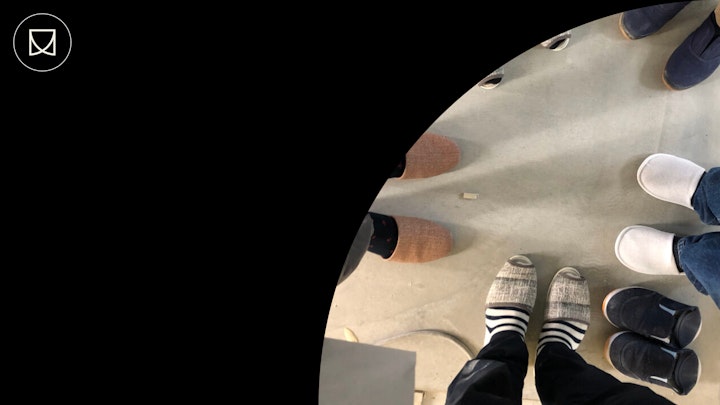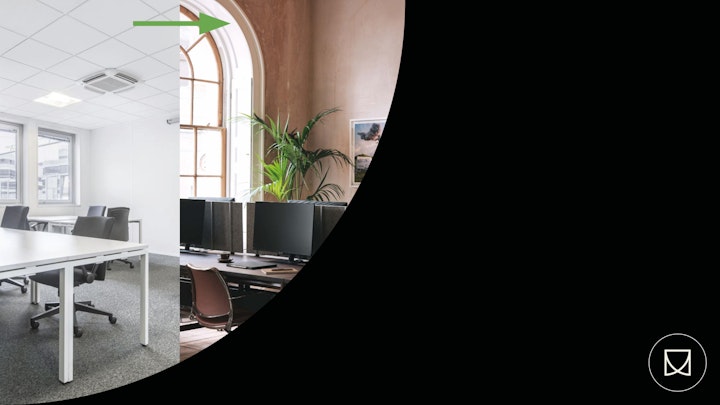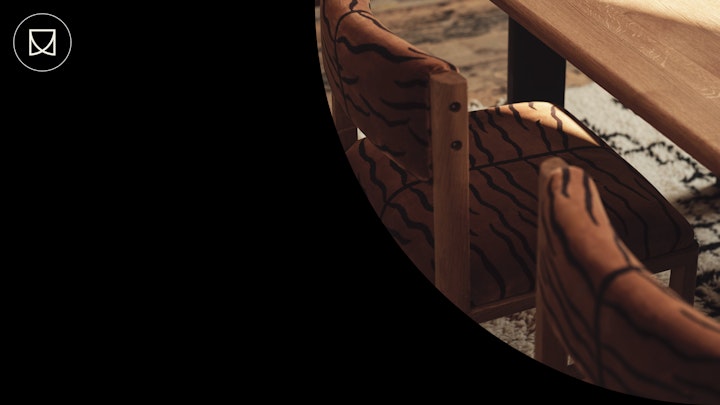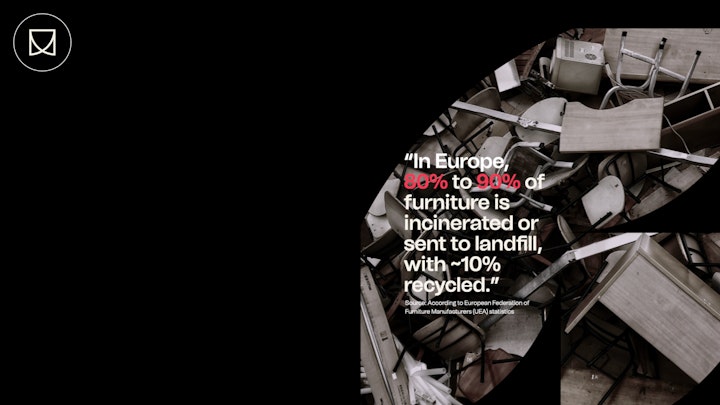For a designer, your ideas are currency
As a designer and creative thinker, my primary market value is the sum of my ideas and experiences. In the first quarter of 2021, I needed to take some time to refill my creative idea bank.
I was exhausted, and even though before I left WeWork, we managed to repurpose over 50% of the furniture inventory, I was still a little shocked by how much waste there was, primarily because around 10–20% of the furniture was useless. It wasn’t easy to reuse due to its design properties, or the designers didn’t want it because it was out of style.
Trends do matter, too
(cue designer violins) As an interior designer, I’ll play my union card here as I understood their pain in using objects that were not durable or functional enough and lacked the aesthetic quality desired at the time. Sure, that last point is subjective — But a two-tone sofa in yellow and red is not that versatile and is pretty tricky to place in a project (other than Mickie d’s) and make it look and feel like it was intentional. The team made it work, though.

What if furniture could time travel?
During my creative break, I discussed the furniture industry, its wastefulness, and its future with Marc Richards, CEO of CE International, and Furniture producer Roger Lewis. We were kindred spirits, and together, we developed [Capxule], an idea for a custodial system where we reduce waste because the furniture could transcend time.
Although we never managed to translate our ideas into an operating business, I have felt that we were definitely on the right path, and who knows, we could bring the service to market in the future.
The linear taking system
The main takeaway from our time together was that we understood that the’ linear system’ is the core facilitator in creating furniture waste. We both understood that whatever the solution is, it needs to be commercially viable — not just wrapped up in sustainability superlatives.
Let’s take a moment to understand what the linear model is and show how it perpetuates too much waste:
- Finite resources are extracted from nature to make ‘stuff’ that eventually becomes waste. Products typically head in one direction towards landfill.
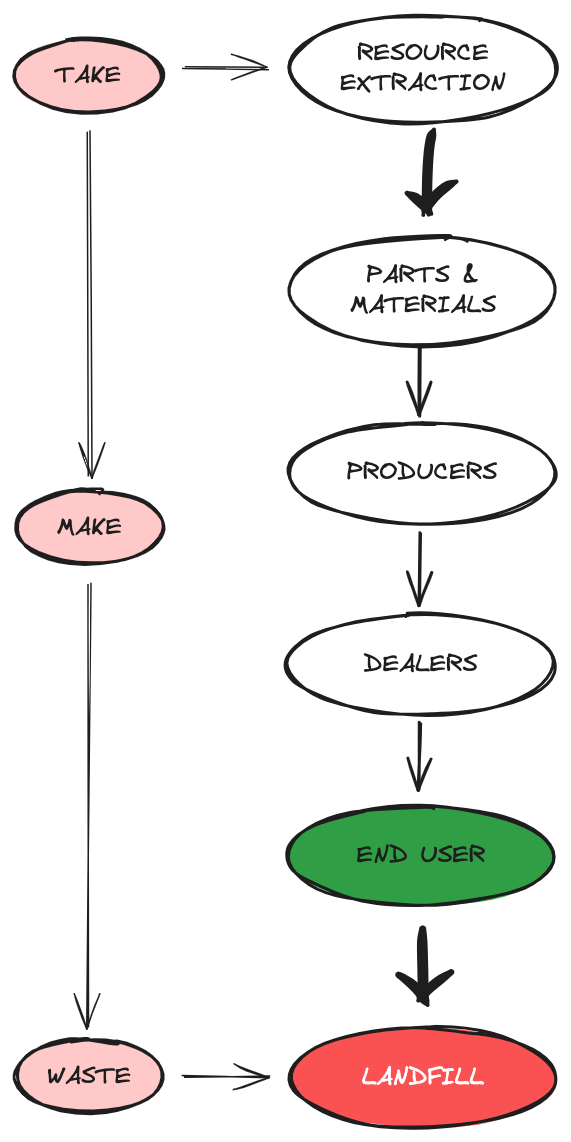
Diagram of the linear model
What does the data say?
- According to the United States [EPA] 2018 estimates, up to 8.5 million tons, or 17 billion pounds, of office assets end up in US landfills annually.
- Furniture waste generated in 2017 totalled [12.2 million tons], and 80% of it went to landfill
- Waste management represents up to 4% of a business or organisation’s costs.
- According to the Business and Institutional Furniture Manufacturer’s Association [BIFMA], $14.7 billion worth of commercial furniture and equipment was produced, sold, and used in 2019 in the US alone.
Why is waste created?
One of my core objectives is to understand and investigate why furniture waste is created in the first place. Instead of thinking about the problem from a systems design perspective, I wanted to focus more on the product design/end-user side of the problem (where I feel most comfortable).
After dusting off some of my old notes from 2021, I found myself drawn back to a book I first read at university (2004) called Emotionally Durable Design by Jonathan Chapman. Throughout the book, he teased the idea that many objects lack empathy and the ability to sustain a relationship with their user. I re-read some essential parts and found it interesting that his writing was well before the rise of the ‘Circular Economy’ and its principles and framework. So, his material is broad, layered with nuance and, for me, super thought-provoking.
“Developed world consumer desires relentlessly grow and flex, while material possessions remain hopelessly frozen in time” — pg 20 (Emotional Durable Design, By Jonathan Chapman)
Having found my groove, inspiration and niche area of focus — I’ve identified and distilled my years of experience into 4 key reasons we create waste (specifically in the furniture industry):
Commercial Reasons — Fast furniture & greenwashing
- A race to the bottom for producers competing in a saturated market results in low-quality and low-cost products.
- Corporate messaging & PR to convince consumers that their products and policies are environmentally friendly.
Societal Reasons — Fast trends & Throwaway culture
- Changing design trends encourage consumer behaviour to buy new and replace, exacerbated by social media.
- The low cost and near-instant accessibility of fast furniture reinforces the disposable mindset.
Empathic Reasons — Desired change & failed relationships
- Consumption is a function of our desire to explore our self-identity and personality.
- Fast furniture is ‘frozen in time’ and incapable of sustaining long-term relationships with its users.
Practical Reasons — Unaware & Poor design choices
- Lack of awareness of the appropriate disposal channels.
- Created with materials and parts that are difficult to recover, repair and reuse.
Funny enough, these 4 reasons became my ‘why’ to keep going with this… But, as I drafted them, I realised that I was missing something, which JC explains nicely:
“Sustainable design has developed a tendency to focus on the symptoms of the ecological crisis rather than the actual causes.” — pg 10
These 4 reasons are, in fact, ‘symptoms’ of a more significant problem, and they show up as waste created — but it dawned on me they are not the primary cause…So, before considering what actual design solutions I could develop, I looked for insight into a potential cause.
Consumption, mass production & debt
Over the years, we’ve become comfortable consuming furniture ‘faster and faster’, with trends fleeting and the heirloom days well and truly behind us. It’s no surprise that most of the waste ends up sent to landfills.
To keep up with the competition and satisfy the market’s desire for more affordable options, producers tend to turn to cheaper, low-quality materials and other unsustainable methods to maintain profit margins.
It’s not hard to see that these two forces have negatively impacted the environment:
“Within the last 50 years alone, the world has lost over a quarter of its ancient rain forests, posing a large threat not only to biodiversity but also to the planet’s air quality. In addition, both carbon dioxide emissions and consumption of fossil fuels themselves have increased almost 400 percent within the same period” — pg 32 (Emotional Durable Design)
In the same chapter of the book, JC also outlines the dark side of our consumption habits and states that “Consumption is natural,” which I thought was genius clickbait…
“Ask a developed world human to stop consuming and you might as well ask a vampire not to suck blood” — pg 29
That’s another brilliant quote that made me wonder what drives the desire to consume mass-produced ‘fast furniture’.
I’m clutching at straws, but I suspected that over the same 50-year period that the environment has declined, there would be some correlation between increasing debt, mass production and excess consumption. I looked around online for some data, and here is what I found:
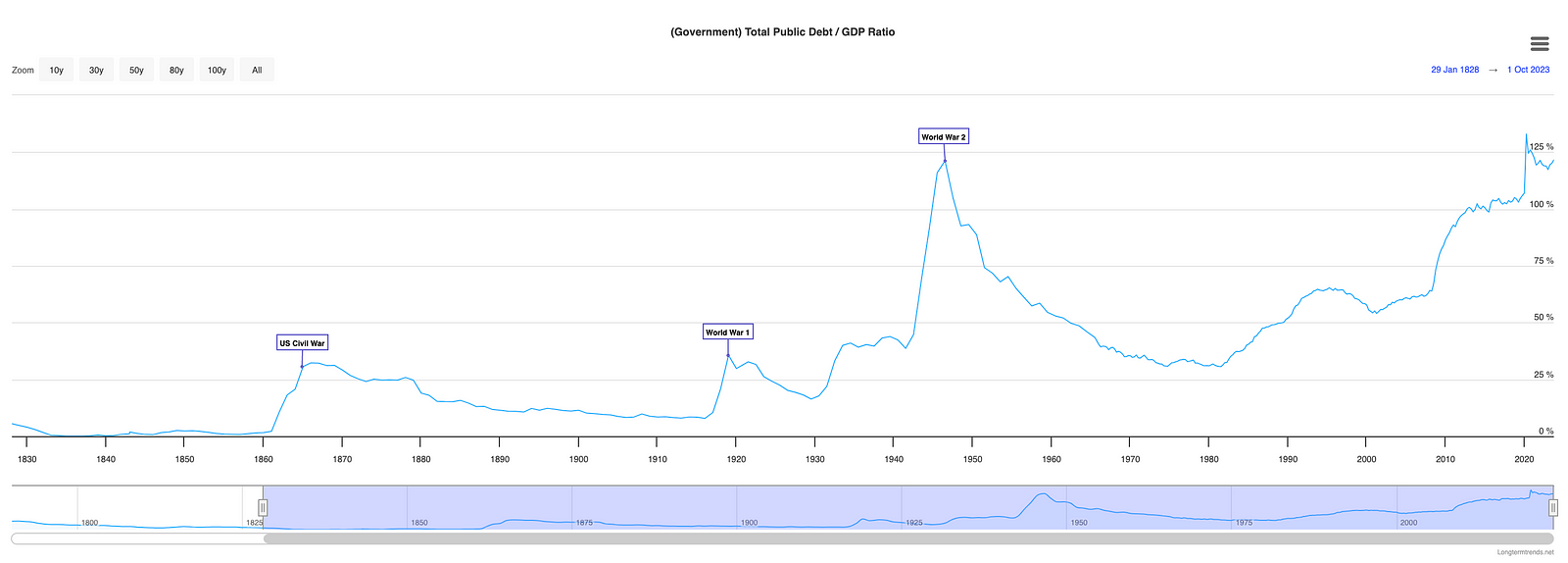
During the war years, national debt levels increased mainly because of the need to build a war machine. This extra government spending, fuelled by debt expansion, helped solidify the US as the world’s leading manufacturing nation.
Mass production (standardisation of goods and the assembly line), which developed in the early 20th Century and was popularised by Henry Ford, helped facilitate post-war reconstruction and is sometimes credited with the 1950s and 60s, commonly known as the Golden Era of economic growth.
This Era was also the period when we became preoccupied with consuming ‘stuff’ after years of poverty and wartime hardship. Buy now, pay later schemes popped up (Credit cards came in 1959), and we now had a perfected linear system for creating more stuff.
“During the 1970s, however, its underlying crisis tendencies became more evident. The growth potential of mass production was gradually exhausted, and there was intensified working-class resistance to its alienating working conditions; the market for mass consumer durables became saturated; a declining profit rate coincided with stagflation; a fiscal crisis developed.”Source: [Britannica Money]
**The following is my distilled and somewhat oversimplified summary of a complex and nuanced system**
So, debt increased to build the ‘mass-production war machine’, which incentivised producers to create more stuff; in return, the stuff became more accessible and affordable for more people. The consumption wheel began.
However, when the recession hit in the 1970s, high interest rates and austerity measures were prominent (sound familiar?), and the average person began to feel the pain. As the cost of living and unemployment rose, the excess (mass-produced) ‘stuff’ created became less valuable and lacked meaning, a breeding ground for waste creation.
Data on waste generated since the 70s
According to the US Environmental Protection Agency, 1980 to 2018:
In 1980, 4,760,000 million tons of furniture was generated
- 98.1% sent to landfill
- 1.89% material recovered for energy
- 0% recycled
In 2018, 12,080,000 million tons of furniture was generate
- 80.1% sent to landfill
- 19.5% material recovered for energy
- 0.4% recycled
Since 1980 in the US:
- A 154% increase in furniture supply
- 2,522% increase in the amount of material recovered for energy
- 107% increase in furniture sent to landfill
Source: [EPA]
Across the pond in Europe and according to the European Federation of Furniture Manufacturers (UEA) statistics, 80% to 90% of the EU furniture waste in MSW is incinerated or sent to landfill, with ~10% recycled. [Source: EEB]
In summary, we are producing more furniture, and although compared to the 1980s, we are sending less to landfills, which is positive, it’s still too much to bear.
What about the debt:
The US debt increased 224% from 33% to 106% during the same 1980–2018 period, which means that the government now borrows (consumes) more than the country produces. From the top (government) down to the average consumer, we live above our means, which explains the accelerated rise of ‘fast everything’. [Source: US Debt to GDP]
And the Demographics:
The US population increased 49% from 223 million to 332 million during that same time. More people that need and want more stuff. [Source: Macrotrends]
A complex situation and path ahead
To conclude, there is no singular cause I can point to with certainty for waste creation. The linear model and the reasons why we waste is a nuanced and complex system that has taken years to evolve. As society, economics, and technology changed, so did the means of production. The economic reality (on the supply side) is that the linear system has been profitable for many. So, the status quo will continue without disruption unless there is a compelling and competitive cost benefit for producers.
However, as a designer and enjoyer of lovely things — my role is to help drive change on the demand side of the equation. Can we help change the mindset of a generation where we cherish high-quality ‘stuff’ again? What if the popular and in-demand stuff happens to be repairable, versatile, and remanufactured and even if the user decides they don’t want/need it anymore — it can be recycled with relative ease?
It’s taken me 5 years to get here, and now I’ve stumbled upon my path with enough insight to create and develop a furniture collection that can tackle the waste issue by being:
“Circular By Design”
Thanks for reading.
IAMDC


